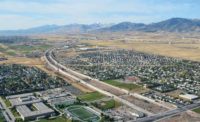First Section of Ambitious Mountain View Corridor Opens to the Public
The parallel, three-mile stretches of frontage road crossing what used to be farmland west of the Utah County city of Lehi might seem simple enough, but they are the key first portions of the Mountain View Corridor to open for public use. The project is an ambitious 35-mile freeway, transit and trail system connecting 13 municipalities along the western edge of the Salt Lake Valley.

The $120-million project, known locally as 2100 North, includes design, right-of-way acquisition and construction of the roads, two railroad overpasses, two bridges over the Jordan River and improvements to the river’s trail system.
The one-way, two-lane roads, one eastbound and one westbound, connect Interstate 15 at Lehi on the east to Redwood Road, a major north-south highway on the western end of the Salt Lake Valley. The space between the roads will eventually become a freeway when the Mountain View Corridor project is built-out over the next 10-15 years, according to the Utah Dept. of Transportation.
“This is a significant milestone to open the first section of the Mountain View Corridor in the community,” says UDOT Project Director Teri Newell. “As communities expand in Northwest Utah County, the need for a transportation system to support the growing population is crucial.”
Ed Rock of New York-based Parsons Brinckerhoff says the company has been working with UDOT on the overall design of the Mountain View Corridor since 2003. He says the goal for this first section was to stay within budget and design in anticipation of future build-out. “The money for the freeway was not available now nor is a freeway needed at this point,” says Rock. “We designed this section to preserve right-of-way for the freeway and to add capacity for now and to have interchanges for the freeway in the future.”
The design team also worked with the Utah Transit Authority in constructing an overpass for the commuter rail line to Utah County, currently under construction. The commuter rail lines run parallel to active Union Pacific lines so they also required an overpass.
“To save future costs and disruptions, we included the Union Pacific and UTA bridges in this project,” Rock says. “We left the existing UP track in place and built the commuter rail bridge. Then, since there is not an active commuter rail line yet, the UP traffic could be put onto that without having to do expensive shooflys while we got the UP bridge rebuilt.”
Rock says building on the site, which was primarily agricultural land and former river bottom, posed a few challenges. “We had to minimize impacts to the wetlands and stabilize the soils right up to the river,” he says.
Kendall Page, project manager and chief estimator for the project’s general contractor Hadco Inc. of Lehi says just over a million tons of surcharge fill was hauled into the site.
“We had some areas that settled almost twice as much as we expected,” says Page. “That delayed us some, but we were able to work in other areas while we waited for the surcharge to settle.”

